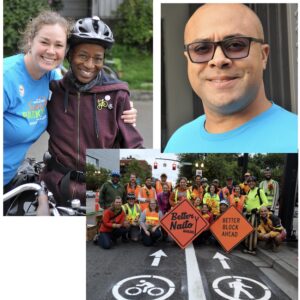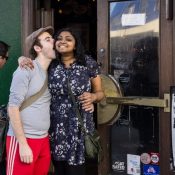It’s that time of year when Portland’s tactical urbanist group Better Block PDX considers your requests on how best to re-invent streets and public spaces.
What is Better Block? Inspired by a national nonprofit, it’s a group founded in 2013 by volunteer planners, engineers, students and activists. Among their accomplishments is lighting the fires under the Portland Bureau of Transportation that led the agency to construct the SW 3rd Ave/Ankeny Street plaza and Better Naito just to name a few. Their approach is simple, yet profound: To create temporary “pop-up projects” that re-imagine streets and public spaces to be human-centered, inviting and fun. When done correctly, these exciting pop-ups might even become permanent (as was the case with the two aforementioned examples).
The official opening date for the 2019 BBPDX RFP begins this Friday February 1st and runs through March 1st. According to BBPDX, “The projects selected will go through Portland State University’s Project Pathway program where urban planning, civil engineering, and communication students produce public engagement, traffic analysis, and design plans for the projects.” In other words, they can take your idea and vision and turn it into reality.
Advertisement
View the RFP below:
[pdf-embedder url=”https://bikeportland.org/wp-content/uploads/2019/01/RFP-Draft-1-25.2.pdf”]
When you’re ready to submit your idea, you’ll need to write up an outline, demonstrate community support, have an idea of success metrics, and sketch up a rough site plan.
Projects suitable for the RFP include: community events, block parties, street seats and parklets, pedestrian plazas, bicycle facilities, open streets, pop-up crosswalks, and signane. Good pop-up projects will have a community engagement component, need limited resources for implementation, and attract attention, curiosity, and conversations.
The submission form is available online.
— Jonathan Maus: (503) 706-8804, @jonathan_maus on Twitter and jonathan@bikeportland.org
Never miss a story. Sign-up for the daily BP Headlines email.
BikePortland needs your support.






I’m not intending to criticize Better Block, but these small intersection interventions are small potatoes compared to what tactical urbanism is really about, IMO.
It’s more about getting diverse mid-level agency staff from different agencies who don’t normally talk with one another because their bosses don’t allow it, to meet on neutral ground with interested neighbors, NGOs, developers, lawyers & corporate engineers, to design and discuss projects that are well outside of the proverbial box.
What I’d do if I was still living in Portland (and am now doing it’s equivalent here in NC) is identify a short list of the nastiest city-owned intersections, then build a coalition of reliable volunteers to help redesign one or two of those intersections (Nick Falbo & Terry D-M would be good at this.) The important part is not the design itself, but getting all the agencies to work with one another on the design and agree on a common solution. At a minimum you need PBOT, ODOT (even if isn’t their street), TriMet, PBA, the local business association whoever they are, all impacted neighborhood associations within a half-mile, local schools and/or universities, insurance underwriters, and various utilities. Your “natural” allies are other NGOs (Street Trust, Oregon Walks, BikeLoud, PDX Transformation), realtor associations, hospitals, police, fire, and safety organizations.
And what’s in it for you as a cyclist? Aside from possibly fixing a difficult intersection and getting the political will to do so, you can finally start to really advance bicycle advocacy in Portland by building a more solid coalition of like-minded organizations and alliances, including groups you’d probably never thought as allies before, such as personal-injury lawyers and realtors. The point is to work outside your usual environment and (usually economically poor) allies, for you to trust them, and for they to trust you.
Any community support for fixing the gap on Skidmore?
I wish the City would get serious about making safe, simple connections between Greenways, to evolve the bike infrastructure segments into a network. My favorite example is Skidmore between N Interstate Ave and the planned greenway on NE 7th or NE 9th. If buffered/protected bike lanes were added, the Concord, Michigan, Going and Rodney greenways would become interconnected with safe crossings of Interstate Ave, Mississippi, I-5, Williams, Vancouver, MLK, and 7th. This route would also connect the Greenways to the busy Vancouver/Williams bike lanes, the Interstate Ave bike lanes, and the planned 7th or 9th Greenway and Sullivan’s Crossing. This route would provide people on bikes safe and comfortable ways to move between NE and N Portland and access the commercial streets in Kenton, N. Killingsworth, along Interstate, Mississippi, Williams, MLK and Alberta.
To illustrate its potential, take a trip from west to east along the current Going Greenway. Beginning from the west at the intersection with N Concord, Skidmore starts out as greenway between Concord and Interstate (this is good). Then it becomes a nice wide, buffered bike lane east of Interstate (also good). At Michigan Ave, the bike lane abruptly disappears so people on bikes cannot take advantage of the 4-way stop sign to control traffic. IF the bike lanes continued on Skidmore, people on bikes could travel a direct route along one road and take advantage of safe crossings with signals at Williams, Vancouver, MLK and 7th.
To continue the journey, PBOT directs people on bikes to go north on Michigan one block, jog back west 1/2 block, then another block north to Blandena. Once on the PBOT “bike facility,” people on bikes are left to their own devices to cross Mississippi/Albina without the benefit and safety of a 4 way stop. Then they must turn onto Vancouver without a signal, and immediately merge across the motor vehicle lane and turn left on Going (note: the westbound route is completely and bafflingly different). Next you come to Williams; again, no signal. Travel few more blocks to MLK: 2 lanes of traffic southbound and 2 lanes northbound, State Highway, fairly high speeds: what PBOT calls the “double threat!” Does PBOT provide a signal? Nope! Just “frogger” your way across to the median (about 8 feet wide) and hang out there until you dare to cross the rest of the street (remember, there is an existing signal 1 block south on Skidmore that connects to the bike lanes and greenway further west, also on Skidmore). Finally, you come to 7th; there is no traffic control here, either (but there is a 4-way stop sign on Skidmore!)
Blandena is a sorry excuse for a bike connection! Skidmore is direct, flat, and has existing signals/stop signs at every dangerous crossing plus a bridge over I-5. Skidmore connects a whole bunch of bike segments in North and Northeast Portland and links a a bunch of neighborhoods and shopping districts. Bike lanes on Skidmore will create a safe, navigable, and meaningful bike connection for cheap!